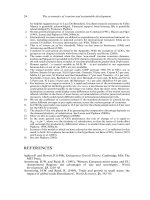THE ECONOMICS OF MONEY,BANKING, AND FINANCIAL MARKETS 387
Bạn đang xem bản rút gọn của tài liệu. Xem và tải ngay bản đầy đủ của tài liệu tại đây (38.66 KB, 1 trang )
CHAPTER 14
Explaining the
Success of
Futures
Markets
Risk Management with Financial Derivatives
355
There are several differences between financial futures and forward contracts and
in the organization of their markets that help explain why financial futures markets, like those for Canada bonds, have been so successful.
Several features of futures contracts were designed to overcome the liquidity problem inherent in forward contracts. The first feature is that, in contrast to
forward contracts, the quantities delivered and the delivery dates of futures contracts are standardized, making it more likely that different parties can be
matched up in the futures market, thereby increasing the liquidity of the market. In the case of the 10-year Canada bond futures contract, the quantity delivered is $100 000 face value of bonds, and the delivery dates are set to be the
last business day of March, June, September, and December. The second feature is that after the futures contract has been bought or sold, it can be traded
(bought or sold) again at any time until the delivery date. In contrast, once a
forward contract is agreed on, it typically cannot be traded. The third feature is
that in a futures contract, not just one specific type of Canada bond is deliverable on the delivery date, as in a forward contract. Instead, any Canada bond
that matures in more than 10 years and is not callable for 10 years is eligible for
delivery. Allowing continuous trading also increases the liquidity of the futures
market, as does the ability to deliver a range of Canada bonds rather than one
specific bond.
Another reason why futures contracts specify that more than one bond is eligible for delivery is to limit the possibility that someone might corner the market
and squeeze traders who have sold contracts. To corner the market, someone
buys up all the deliverable securities so that investors with a short position cannot
obtain from anyone else the securities that they contractually must deliver on the
delivery date. As a result, the person who has cornered the market can set exorbitant prices for the securities that investors with a short position must buy to fulfill their obligations under the futures contract. The person who has cornered the
market makes a fortune, but investors with a short position take a terrific loss.
Clearly, the possibility that corners might occur in the market will discourage people from taking a short position and might therefore decrease the size of the market. By allowing many different securities to be delivered, the futures contract
makes it harder for anyone to corner the market because a much larger amount of
securities would have to be purchased to establish the corner. Corners are more
than a theoretical possibility, as the FYI box, The Hunt Brothers and the Silver
Crash, indicates, and are a concern to both regulators and the organized exchanges
that design futures contracts.
Trading in the futures market has been organized differently from trading in
forward markets to overcome the default risk problems arising in forward contracts. In both types, for every contract there must be a buyer who is taking a long
position and a seller who is taking a short position. However, the buyer and seller
of a futures contract make their contract not with each other but with the clearinghouse associated with the futures exchange. This setup means that the buyer of
the futures contract does not need to worry about the financial health or trustworthiness of the seller, or vice versa, as in the forward market. As long as the clearinghouse is financially solid, buyers and sellers of futures contracts do not have to
worry about default risk.
To make sure that the clearinghouse is financially sound and does not run
into financial difficulties that might jeopardize its contracts, buyers or sellers of
futures contracts must put an initial deposit, called a margin requirement, of
perhaps $2000 per Canada bond contract into a margin account kept at their
brokerage firm. Futures contracts are then marked to market every day. What









